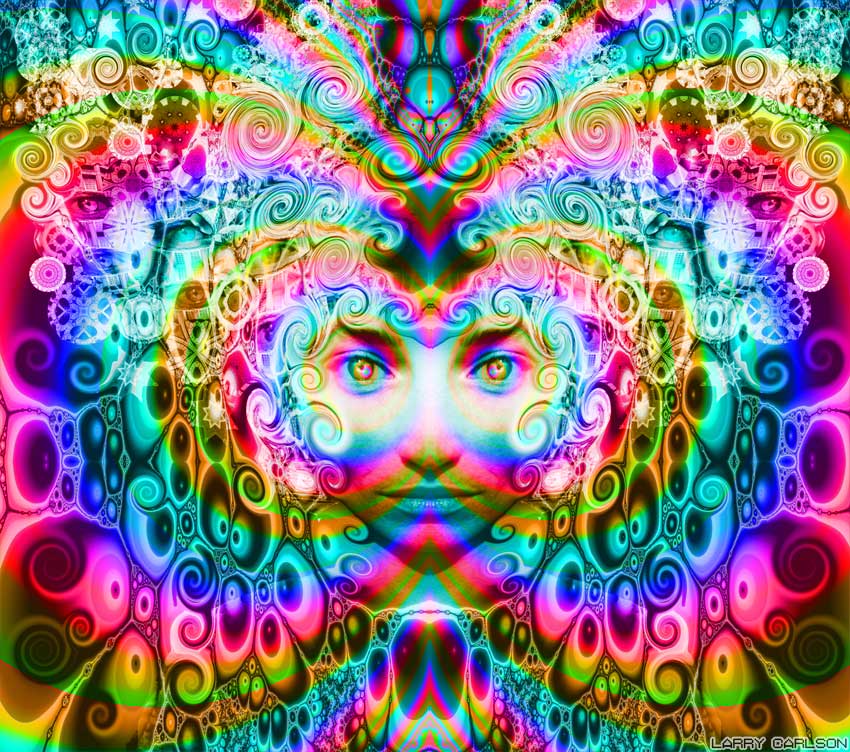
Why “Psychedelic” Information Theory
The bulk of human consciousness exists in a linear range which goes from highly focused and alert to deep asleep and dreaming. Most states of consciousness are experienced uniformly and independently of each other along this linear spectrum. For instance, when you are asleep you are not awake; when you are focused you are not daydreaming; when you are anxious you are not relaxed. The fact that consciousness exists in only one state at one time is an indication that the system is linear and stable. When two distinct perceptions or states of consciousness overlap at the same time this is an indication that the system is unstable, and in most cases where divergent states of consciousness overlap the output is viewed as a pathology. State-divergent pathologies are typically treated with drugs targeted to amplify the positive traits and/or dampen the negative traits.
The term psychedelic means “mind manifesting,” which implies that all potential states of mind may be manifested under the influence of psychedelic drugs. If normal consciousness moves in a straight line along a spectrum of many possible states, psychedelics represent a unique and reversible destabilization of this linear spectrum where consciousness can assume multiple points of consciousness simultaneously. The most extreme divergent state of consciousness is described as being wide awake while simultaneously dreaming, a state clinically referred to as psychosis or hallucination. The emergence of multi-state consciousness under the influence of psychedelics represents a system that has destabilized from linear output and has become nonlinear and exponentially complex. Thus, in psychedelic perception the linear functions of consciousness diverge into a complex nonlinear state where multiple perspectives and analytical outputs may be experienced simultaneously.2 According to PIT, this destabilized state of nonlinear complexity is where new information is generated in the human mind. Understanding the dynamics of this unique nonlinear the informational limits and potential complexity range of all human consciousness.
What is “Shamanism in the Age of Reason”?
PIT seeks to describe a model of psychedelic activation that can be adapted to all possible permutations of human consciousness, including group mind states, mystical states, and transpersonal awareness. The ritual of using psychedelics to generate new information, bond with peer groups, and program human belief is traditionally called shamanism, so PIT is a study of the practice of shamanism, which can also be called applied psychedelic science. The practice of using ritual techniques of spiritual transcendence to manipulate belief systems has been popularly dubbed chaos magic, which is an occult blend of neo-shamanism, cognitive theory, and social theory (Fig. 3). Chaos and complexity are also popular terms applied to the study of nonlinear systems, such as fractals and cellular automata, making chaos magic and shamanism spirituo-scientific explorations of the generative function of nonlinear systems.
While PIT focuses on physiology over mythology, it is clear that there is a fundamental human desire to achieve states of consciousness subjectively described as Gnostic or spiritually enlightening. It is the conjecture of PIT that all mystical states, including healing and regenerative states, have unique formal nonlinear qualities that can be described in physical terms close enough to make good approximations. This means that PIT is also a work of technical shamanism, neurotheology,or spiritual neuroscience, and can be referenced in the clinical application of psychedelic drugs in shamanic ceremony, mystical ritual, or psychedelic therapy.

Generic Application, Neutrality, Margin of Error
PIT does not attempt to provide precise definitions of consciousness, perception, or the psychedelic state. Instead PIT attempts to model an approximation of psychedelic consciousness based on the known functions and limits of human perception and cognition. According to PIT, if a functional reproduction of consciousness existed then it too could be made to have a psychedelic experience. This also makes PIT a text on artificial intelligence which can be tested in mechanical systems of perception. While this text may contain some assumptions and conjecture on human brain function,
the fundamentals of PIT are generic enough to apply to any system of consciousness which relies on real-time frame perception for interacting with reality. Although the bulk of the text focuses on states of hallucinogenesis afforded most readily by the tryptamines LSD, psilocybin (magic mushrooms), and DMT (found in the South American brew ayahuasca), and their action at the 5-HT2A receptor subtype, PIT strives to be generic and substance neutral, meaning that the fundamentals of PIT should apply to all drugs and techniques which produce hallucination, even though they may target different receptors and/or destabilize consciousness in a wholly unique way. function is essential to understanding the informational limits and potential complexity range of all human consciousnessthology.
……………………………..
Check out more at Larry Carlson
